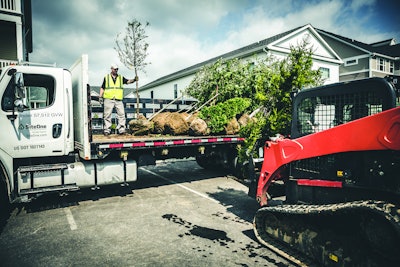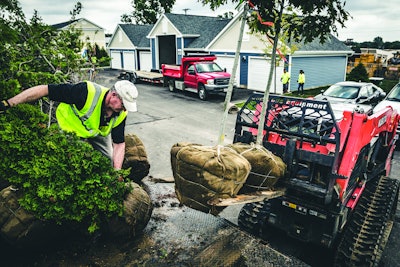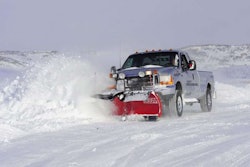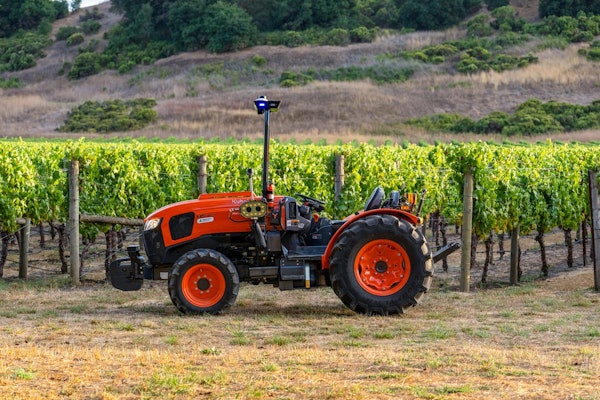 Photo: SiteOne
Photo: SiteOneWinter can be a slow time for business, especially if you don’t offer snow removal or Christmas lighting services, but there are still ways to keep your employees busy.
While your sales and design teams can plan out the jobs for the upcoming new year, your installation crews may be looking for something to do.
Depending on the area you are located in, you can actually get a head start on next spring by planting trees as long as the ground is not frozen. George Wolf with SiteOne says any species can be planted in late winter as long as it is appropriate for the USDA zone you’re working in.
He does warn that late winter planting isn’t exactly the ideal time, but it is doable.
“I don’t see a true cultural benefit to planting in late winter in terms of blooming, establishing roots or increased survivability,” Wolf says. “Only real benefit I can see is that a landscaper could level out peak labor demands by planting trees prior to the spring season kicking in. There is no horticultural benefit that I am aware of to be gained from planting in late winter.”
Issues to be aware of
If client or labor needs cause you to need to start planting trees in late winter, here are some of the issues you need to be prepared for and may prevent you from starting at all.
1. Availability of stock
Wolf says that container stock or trees that have been harvested and burlapped during the fall digging season are ideal for late winter planting.
“Planting trees in the winter would be similar to being ‘mulched in’ at a nursery yard or grower for protection from the winter elements,” he says.
 Photo: SiteOne
Photo: SiteOneThe problem that might occur, depending on your location, is if the nursery has already winterized their operations. If the plants are already mulched in for the season, you might not be able to start installing in the winter, even if you wanted to.
Wolf also says you should determine if what you are planting is fresh or tired stock from the prior season.
“Not all product leafs out in spring, so what is your course of action if the tree does not leaf out?” Wolf says. “If you wait until spring, you can think about using trees of a greater caliper, such as SiteOne specimen trees, to give you a jump on the season.”
2. Frozen soil
If the ground is frozen, digging will be nearly impossible and the tree will likely suffer from reduced root growth and eventual tree decline.
Wolf adds that frozen soil will prove challenging to get a good mixture of soil and soil amendments mixed in the planting hole between the native soil and the root ball.
3. Winter threats
Just like how summer has a number of stressors, winter comes with its own set of factors that can prove challenging for trees just getting settled in. These include late winter storms, the ground freezing again and bark splitting just to name a few.
Winter burn, or desiccation, can happen when evergreens lose considerable amounts of moisture through their leaves due to strong winds or sunlight while the roots are frozen, preventing the plant from replacing the lost water.
Sun scald tends to appear on the south or southwest side of a tree during the late winter and early spring. Direct sun can heat the bark enough that the tissue becomes active and breaks dormancy, but freezing temperatures at night kill the active tissue.
One of the most obvious causes of winter damage to plants is snow and ice. Heavy snow and ice can cause tree branches to bend and break.
Newly planted trees and shrubs can allow cold air to penetrate the root zone if cracks in the soil are not properly filled. Mulch and leaf litter tend to keep the soil insulated and prevent the temperature from fluctuating in the winter.
4. Irrigation
While you might not think of winter as a dry time, but it can be a challenge for trees to get the moisture that they need. Wolf says this is more of an issue when planting evergreens in late winter.
“Deciduous trees are dormant in the winter and require very little water,” he says. “Evergreen trees keep their needles and leaves and as a result have a much greater need for moisture. If there is a late freeze or the ground is still partially frozen, it makes it much more difficult for an evergreen tree to get the moisture it needs to support the needles or leaves.”
He also notes it’s important to have irrigation in place for when the tree does break dormancy.
One thing to make clear to clients who may be wanting a tree planted early for spring blossoms is that many transplanted trees or containerized trees do not bloom heavily the first year of planting.
“This is primarily a result of the tree using its energy to establish roots to provide moisture and nutrients for the plant during the upcoming summer season, so in many cases rooting takes priority over blooms and flowers,” Wolf says.









